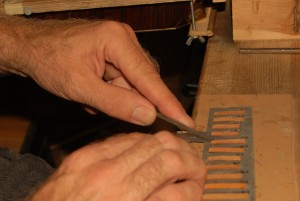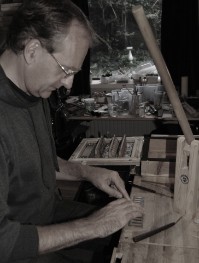Tuning a bandoneon is a specialized and time consuming craft. Before tuning, all reeds and voice plates must be checked for corrosion, dirt and damage. 
In a 142 tone bandoneon there are 276 reeds, each of which must be individually tuned. This is done by working on the reeds with very fine files. The technique used for tuning bandoneons is very different than that for tuning accordeons. Many bandoneons have suffered severe damage from well intended but poorly executed tuning. In many old instruments reeds must be replaced because they have been too deeply scratched, filed away, bent or even broken in prior tuning attempts. The use of small sanding machines –which often damages the reeds- has taken a toll, too. Not only do they damage the reeds, but the heat produced can change the caracteristics of the reed. Reeds that have been damaged beyond repair, must be replaced by hand. I use only original reeds from donor instruments. Before tuning the reeds, the reed valves must be checked thoroughly as they influence the air flow in the direct surroundings of the reed. Before I tune an instrument, I will always consult with the player whether or not the reeds valves must be replaced or adjusted. If needs be, they can be replaced by either (original) all leather valves or by more modern leather valves with plastic support layers. In many instruments the reed plates do not precisely fit to the air ducts directly underneath them, causing air leaks. Because of this air leakage, the instrument can become unstable and a lose a lot of resonance. Before starting the tuning, I optimize the fit of the reed plates to the air ducts. 
Especially when an instument has not been tuned for a considerable length of time, or after a pitch change (i.g. from the old a=435Hz pitch to the standard a=442Hz tango pitch) the instrument will usually have to stabilize for some time, after which it will need a correction tuning. When I do an overall tuning it will always include a correction tuning at some later time. | 
